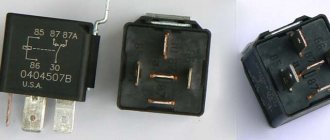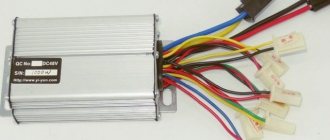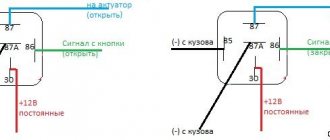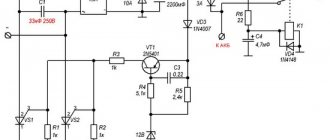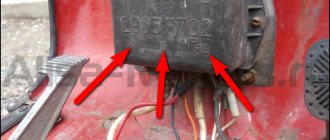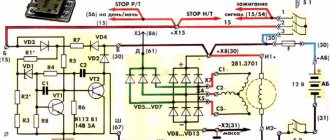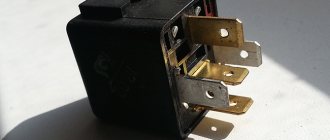Generator G-424
To understand the principle of operation of the generator and relay regulator, a little theory.
Electric generator G-424 is a three-phase machine, with electromagnetic excitation. Generates alternating current. VGB-2A rectifier converts current into direct current. For normal operation of an electric machine, a relay-regulator PP-330 . The job is to regulate the voltage of the motorcycle's on-board network so that it does not exceed 14 volts.
The G-424 generator is not able to work with a discharged battery. To start the engine and increase to 2400 rpm, the motorcycle runs on a battery. Only after this threshold is exceeded does the electric generator operate in self-excitation mode.
Generator G-424 is PROHIBITED to be turned on without load!
Generator circuit G-424: 1 - cover; 2 — oil seal; 3 - rotor; 4 - stator winding; 5 - terminal block; 6 — back cover; 7 — shield assembly; 8 - rectifier block; 9 - fan; 10 — protective casing; 11 - bearing.
Troubleshooting the generator
The method for determining the malfunction was as follows (I tried several methods, since replacing the relay regulator did not help):
Indirect determination of generator performance
This method does not allow you to accurately determine the malfunction of the generator, but it can still be used to determine whether the generator is “dead,” or there is still hope and the cause of the malfunction lies elsewhere.
Disconnect the wire from terminal “Ш” on the generator. And we apply + from the battery to this terminal, bring the wrench to the generator body, it should be magnetic, not much, but it is noticeable. If it is magnetic, then the rotor winding is working properly. Turn it off.
We connect a 12 volt lamp to the “+” terminal on the generator, and the other end of the lamp to ground. And we connect “+” from the battery to the “Ш” terminal. And we turn the engine with the kickstarter, the light should light up. If this happens, then the generator is working.
In my case, the light was on, I changed the relay-regulator, but the battery still did not charge, and when the engine was running, the red battery charge control light did not go out.
Cleaning and testing the generator G 424
- I removed the generator, unscrewed the back cover, pulled out the brushes - the wear was within normal limits, they were checked with a multimeter.
- Using the probes through the windows for the brushes with a multimeter, the armature rang - “it rang”, there is no short circuit to the generator housing.
- I unscrewed the rectifier and it “ringed” like diodes, i.e. In one direction the arrow should deviate, I change the polarity, the arrow does not deviate. Those. the diodes are not “broken”, as they should be.
- I rang the stator windings - everything is normal, there is no short circuit to the housing.
Everything is in perfect order, the generator should be in good working order, so I didn’t completely disassemble it. But there is no charge. Therefore, I began to understand the operation of the relay regulator and look for the reason for it.
If something is wrong.
- Disconnect the relay regulator (remove the connector). Let's take a tester.
- We set the tester to measure resistance. We check the resistance between ground (engine) and the generator wires (three wires, usually yellow). It shouldn't exist. If at least one has it, your motorcycle's alternator has burned out.
- We check the resistance between the generator wires, the resistance should be the same, about 1 - 3 ohms. If it is more or not the same, your motorcycle's alternator has burned out.
- We set the tester to measure alternating voltage. We start the motorcycle, measure the voltage between the generator wires, it should be more than 18 volts at idle, and more than 40 volts at 3000 - 4000 rpm. If there is no or different voltage, your motorcycle's alternator has burned out.
- If the check in points 2, 3 and 4 went well, most likely your motorcycle has a faulty Relay - Regulator or, which also happens, a wiring fault (clean all terminals, check the integrity of the wires, connections to ground). If your motorcycle's generator burns out, this is the place for you: Rewinding the generator with your own hands.
Our service will help you check the charging of your motorcycle.
Check the integrity of wires and connections.
They will eliminate all problems associated with charging the motorcycle.
If the motorcycle is not sufficiently charged, the following may fail: battery, relay - regulator, generator.
Relay-regulator PP-330, troubleshooting
After I determined that the generator was working. I started searching for the faulty relay regulator. To understand the principle of its operation, a little theory.
I will not describe in detail the operation of the relay regulator; I will describe the problem that I fixed. This problem was in two relay regulators, and the reason for it was that due to a long time of inactivity of the contacts, the carbon contacts of the R.N. coil. (in the diagram above) oxidized and did not pass current.
During normal operation of all equipment, the process is as follows. When you turn the key S1: “+” from the battery is supplied to the ignition coil and to the V3 contact of the relay regulator. In the relay, power from the VZ contact passes through the RN coil. and to contact “Ш” of the generator, a rotor winding is connected to it. Thus the armature is excited by the battery. When the engine speed increases, an alternating voltage appears on the “~” contact, the R.KL relay is activated, and the warning lamp turns off.
Also, as the speed increases, the voltage at the “+” contact of the generator also increases. It is connected to the R.N. relay, when a certain voltage threshold is reached, the relay is activated and the power goes not directly through the relay coil with a small resistance, but through the load resistances, thereby reducing the voltage on the rotor. By reducing the voltage level on the rotor, the current strength decreases, and, accordingly, the magnetic force of the rotor decreases. Which leads to a decrease in voltage at the outputs of the stator windings. When the voltage in the relay R.N. decreases The relay holding current drops, thereby the R.N. contacts. return to their original state and the process repeats.
If the generator is spun up without a relay-regulator and a load, but the armature is excited, then as the speed increases, the EMF in the stator windings will increase, which theoretically can damage them (break through the insulation). Therefore, it is prohibited to turn on and spin up the G 424 generator without a load.
In my case, the carbon contacts of the R.N. relay were oxidized , thereby providing insufficient voltage to the rotor to excite it. The generator simply did not produce voltage.
Simply cleaning the contacts solved the problem .
GENERATOR 700 W | OPPOZIT.RU | motorcycles Ural, Dnepr, BMW
The resistance between the windings must be the same. The engine is started and the rotor rotates in the stator winding, voltage is supplied to the excitation winding through the PP and the generator is excited.
As practice has shown, pieces of nails driven into holes cope with the task. If the voltage is outside the technical specifications, replace the regulator. In particular, automatic ignition timing was introduced, since the motorcycle received a new power unit, and the old manual control of the timing advance did not meet the technical requirements. The voltmeter reading is noted and, by bending the shank in the voltage relay, the spring tension is increased, and with it the generator voltage by 0.4 V. An additional rectifier arm is also introduced into the electrical circuit. During this period, you can slightly increase the generator voltage.
On a URAL car there is a voltage regulator. If the voltage is outside the technical specifications, replace the regulator. Adjust the position of the front wedge stops 9 on the closed lid 6 of the container 10 after installing the batteries 1 and the upper clamps into the container. If they come out of the special sockets, the phase leads may break off during generator operation. If the engine continues to run, then the generator is working. The work consists of connecting a generator or battery to the mains at a certain moment. Thus, by turning the additional resistance on and off, a certain generator voltage will be maintained. After installing the batteries on the car, adjust the position of the front wedge stops 9, for which loosen the tightening of the bolts 8 securing the stops 9 to the cover 6, move the stops 9 along the elongated holes of the cover 6 away from you until they stop and tighten the bolts 8.
We recommend reading:
Contact Information.
Thus, by turning the additional resistance on and off, a certain generator voltage will be maintained. Remove the cover from the shaft. But you need to follow some rules. The generator covers undergo minor modifications. Replace brushes protruding from the brush holder channel by less than 5 mm. Features of the development of electrical equipment of Ural motorcycles The six-volt circuit over the years ceased to meet technical regulations, and on subsequent models, manufacturers installed central wiring designed to operate 12V equipment: Ti-volt battery; Let's consider their structure and interaction.
Thus, by turning the additional resistance on and off, a certain generator voltage will be maintained. If the voltage is outside the technical specifications, replace the regulator. Period of years The wiring of the Ural motorcycle has also proven itself quite well - if at first the designers had concerns about loss of contact due to possible corrosion of the metal frame, then operation has shown the reliability of the single-wire electrical circuit. Scooters and mopeds Ural motorcycle wiring diagram Ural motorcycles have a unipolar battery terminal. If after several trips it turns out that the battery is not charging enough, you can further increase the voltage of the generator, but not higher than 15 V. Ural motorcycle wiring diagram
no charging in the Urals 12V
Tell me what to do, the problem is this: in the Urals, when the engine is running at any speed, the charging lamp does not go out, even if on the PP 330 I forcefully press contacts contacts, the lamp goes out but charging does not occur. what could be the problem. At higher speeds and switching the relay, I manually disconnect the battery, but there is still no charging.
Test the relay regulator, most likely this is the cause
Search! I suspect the reason, but I won’t tell you, because... has been discussed several times.
I also had an electronic snout 3702 plugged into it and it charges even faster
I suspect an interturn short circuit in the generator. We tried changing the relay regulator but it does not switch at any speed
break in the excitation winding of the generator
I confirm, 99% winding breakage, go ahead and buy an anchor.
and if the generator was installed by a worker from another motor, everything is the same.
If the charge light does not go out, this does not mean that there is no charging when the engine is running, try removing the minus from the battery. Take a tester and measure the voltage, if the relay is normal and the generator is normal, the problem is in the wires (check two wires Ш and +)
Comrades, I ask you to help me figure this out. I am writing here so as not to create new topics. Patient: Dnepr MT-11 Epicrisis: Generator G-424 with accelerated 17th gear, VAZ relay-regulator, live battery, live brushes, gear like new. Symptoms: No charging at idle and medium speeds. On high ones there is. Everything was fine, then somehow it slowly gradually worsened. . I have a number of assumptions. But I would like to read some practical advice - maybe someone had the same thing. So as not to check everything thoroughly. Please advise to make the correct diagnosis. That's what the forum is for. . On the abyss of the Dnieper and the Urals - Dnieper
Most often the anchor burns out. This usually happens at high speeds. And then there’s the accelerated gear. This is due to the mobility of the winding wire. That’s why overrunning clutches are used on cars. It's easy to check with a tester.
It looks very much like an interturn short circuit in one of the windings, if the regulator is known to be working. What regulator is used? Some classic VAZ regulators have a fuse that is soldered inside into the circuit. An interturn short circuit is difficult to detect unless using an oscilloscope. You can also try measuring the voltage on the stator in each phase with the engine running and the load off. A breakdown of the rectifier block diodes is also possible. To summarize: to find a fault, you still have to check everything thoroughly and thoroughly.
Regulator relay from VAZ, 3702. This one has a transparent cover, inside there are two LEDs - red and green. . I'm not interested in just stupidly replacing the generator and continuing to drive around with women. I'm interested to know where the dog is buried. I would like to be a sniper who immediately hits the target with one shot, using only one cartridge. Being a machine gunner in this case is not interesting. . I'll try to break into the garage one of these days. There is Tseshka. I'll measure everything I can reach without removing the generator. I'll let you know here. No oscilloscope. As a child, I attended a radio club - everything that could be needed at that time was there. But now it’s not like before. . What other assumptions could there be? What is confusing is that there is charging at high speeds. . Oh, and more questions: What should be the resistance on the rotor and stator windings? . On the abyss of the Dnieper and the Urals - Dnieper

